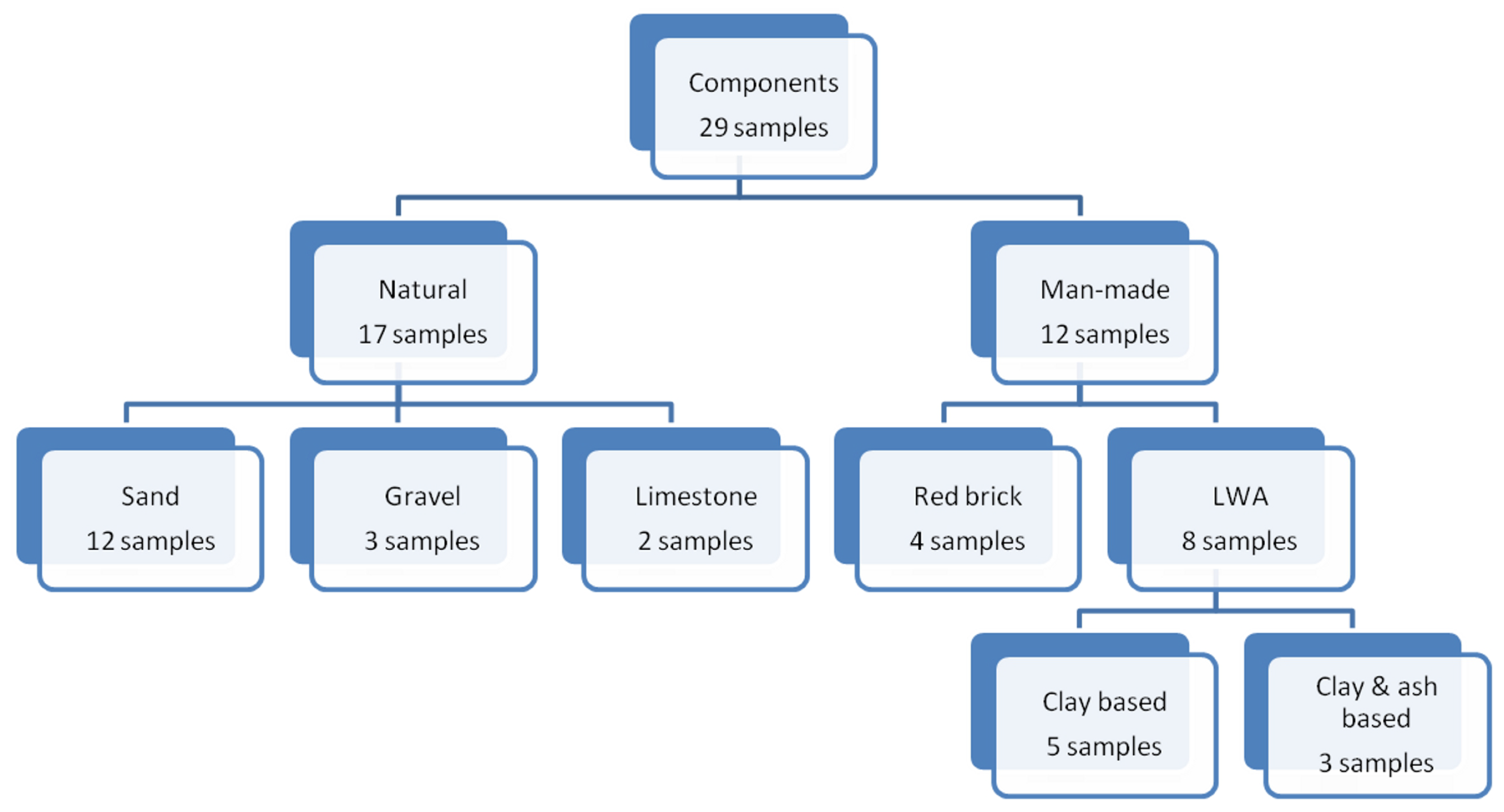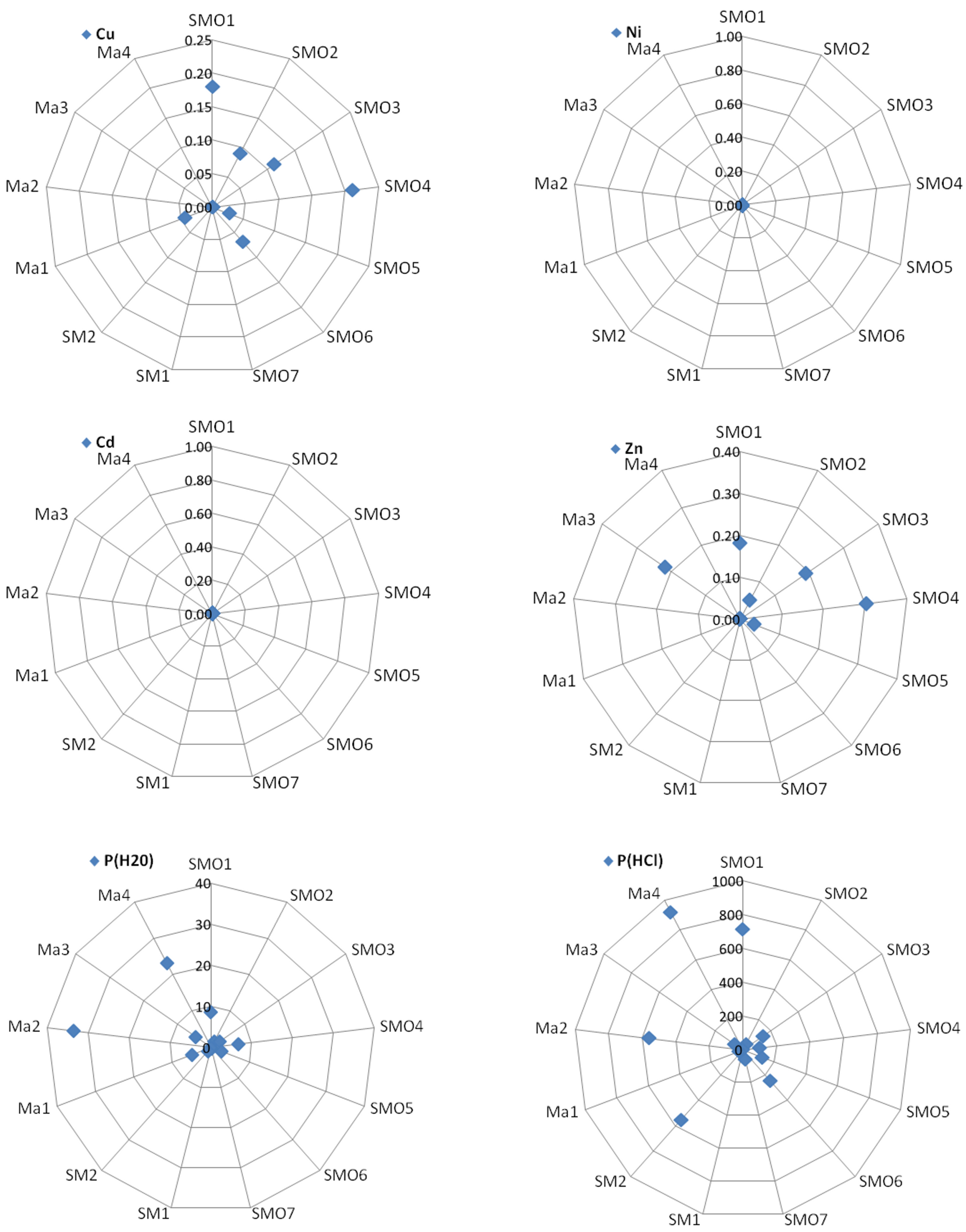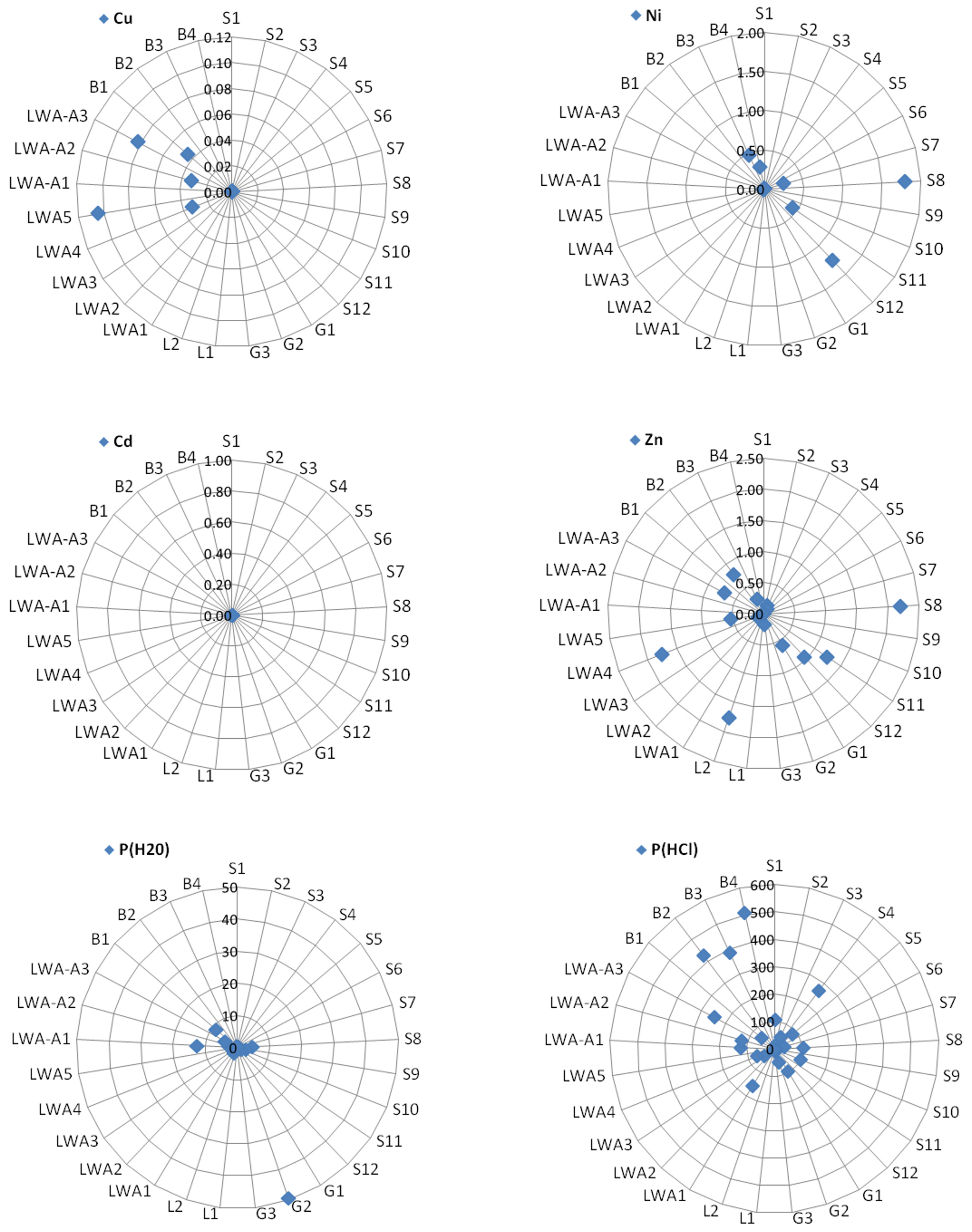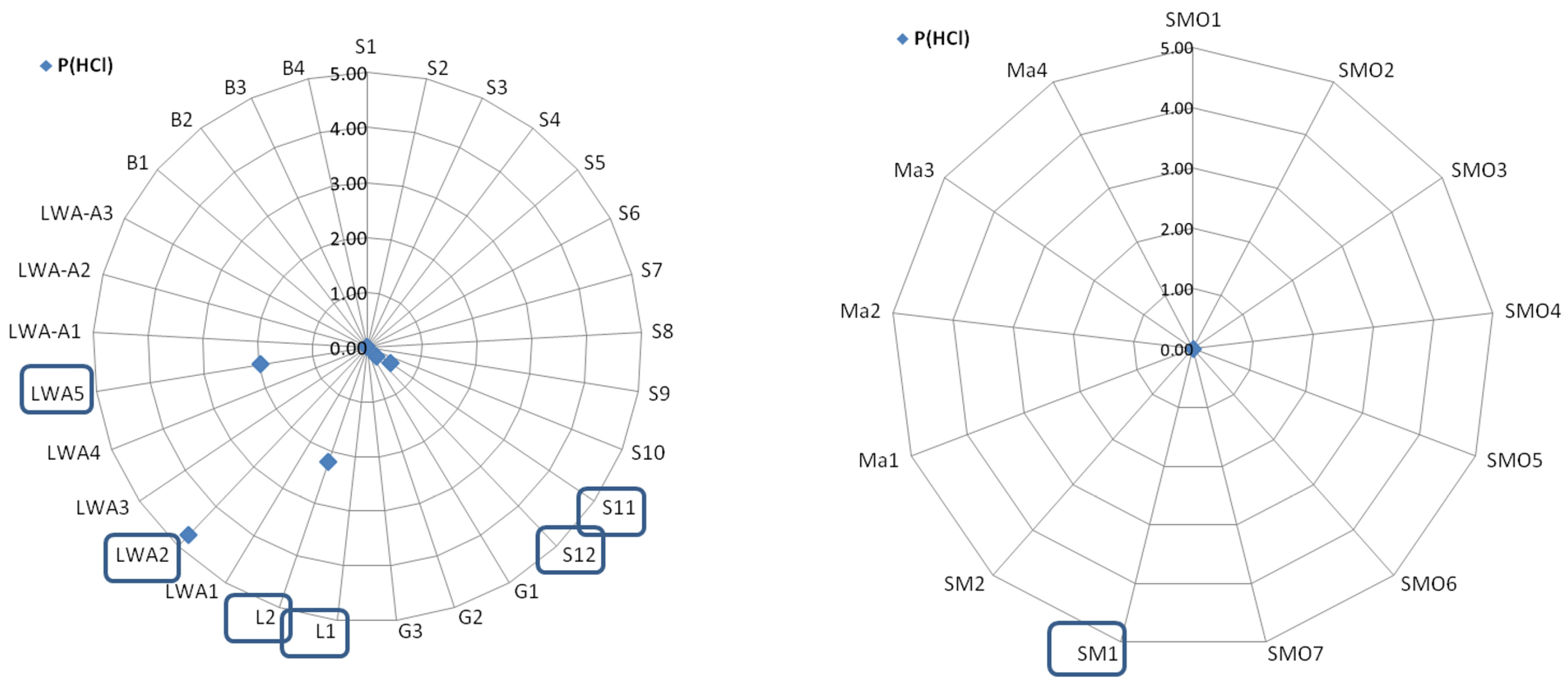Phosphorus and Metals Leaching from Green Roof Substrates and Aggregates Used in Their Composition
Abstract
:1. Introduction
2. Materials and Methods
3. Results and Discussion
4. Conclusions
Author Contributions
Funding
Acknowledgments
Conflicts of Interest
References
- Enzi, V.; Cameron, B.; Dezsényi, P.; Gedge, D.; Mann, G.; Pitha, U. Nature-Based Solutions and Buildings—The Power of Surfaces to Help Cities Adapt to Climate Change and to Deliver Biodiversity. In Nature-Based Solutions to Climate Change Adaptation in Urban Areas; Springer: Cham, Switzerland, 2017; pp. 159–183. [Google Scholar]
- Strategia adaptacji do zmian klimatu dla m.st. Warszawy do roku 2030 z perspektywą do roku 2050. Miejski Plan Adaptacji. Available online: https://pliki.um.warszawa.pl/index.php/s/eHPc5HCkjpzQ2tK (accessed on 16 December 2019). (In Polish).
- Berardi, U.; GhaffarianHoseini, A.H.; GhaffarianHoseini, A. State-of-the-art analysis of the environmental benefits of green roofs. Appl. Energy 2014, 115, 411–428. [Google Scholar] [CrossRef]
- Peng, L.L.H.; Jim, C.Y. Economic evaluation of green-roof environmental benefits in the context of climate change: The case of Hong Kong. Urban For. Urban Green. 2015, 14, 554–561. [Google Scholar] [CrossRef]
- Chen, C.F.; Kang, S.F. Effects of substrates and plant species on water quality of extensive green roofs. Appl. Ecol. Environ. Res. 2016, 14, 77–91. [Google Scholar] [CrossRef]
- Catalano, C.; Laudicina, V.A.; Badalucco, L.; Guarino, R. Some European green roof norms and guidelines through the lens of biodiversity: Do ecoregions and plant traits also matter? Ecol. Eng. 2018, 115, 15–26. [Google Scholar] [CrossRef]
- Song, K.; Xenopoulos, M.A.; Marsalek, J.; Frost, P.C. The fingerprints of urban nutrients: Dynamics of phosphorus speciation in water flowing through developed landscapes. Biogeochemistry 2015, 125, 1–10. [Google Scholar] [CrossRef]
- Paul, M.J.; Meyer, J.L. Streams in the urban landscape. Annu. Rev. Ecol. Syst. 2001, 32, 333–365. [Google Scholar] [CrossRef]
- Barałkiewicz, D.; Chudzińska, M.; Szpakowska, B.; Świerk, D.; Gołdyn, R.; Dondajewska, R. Storm water contamination and its effect on the quality of urban surface waters. Environ. Monit. Assess. 2014, 186, 6789–6803. [Google Scholar] [CrossRef] [PubMed] [Green Version]
- Pluta, K.; Mrowiec, M. Analiza oddziaływania systemów kanalizacyjnych na odbiornik. Inżynieria Ekol. 2015, 45, 183–194. (In Polish) [Google Scholar] [CrossRef]
- IMGW. Ocena możliwości i warunków osiągnięcia celów redukcyjnych HELCOM dla azotu i fosforu. II Bałtycki Okrągły Stół, 13 maja 2014 r. Available online: http://awsassets.wwfpl.panda.org/downloads/prezentacja_imgw_waldemar_jarosinski__ocena_mozliwoci_i_warunkow_osiagnicia_celow_r_1.pdf (accessed on 13 May 2014). (In Polish).
- Toland, D.C.; Haggard, B.E.; Boyer, M.E. Evaluation of nutrient concentrations in runoff water from green roofs, conventional roofs, and urban streams. Trans. ASABE 2012, 55, 99–106. [Google Scholar] [CrossRef]
- Bliss, D.J.; Neufeld, R.D.; Ries, R.J. Storm Water Runoff Mitigation Using a Green Roof. Environ. Eng. Sci. 2009, 26, 407–418. [Google Scholar] [CrossRef]
- Barr, C.M.; Gallagher, P.M.; Bridget, P.E.; Wadzuk, B.M.; Welker, A.L. Water Quality Impacts of Green Roofs Compared with Other Vegetated Sites. J. Sustain. Water Built Environ. 2017, 3, 04017007. [Google Scholar] [CrossRef]
- Ferrans, P.; Rey, C.V.; Pérez, G.; Rodríguez, J.P.; Díaz-Granados, M. Effect of Green Roof Configuration and Hydrological Variables on Runoff Water Quantity and Quality. Water 2018, 10, 960. [Google Scholar] [CrossRef] [Green Version]
- Moran, A.; Hunt, B.; Smith, J. Hydrologic and water quality performance from greenroofs in Goldsboro and Raleigh, North Carolina. In Proceedings of the Third Annual Greening Rooftops for Sustainable Communities Conference, Awards and Trade Show, Washington, DC, USA, 4–6 May 2005. [Google Scholar]
- Czemiel Berndtsson, J.; Emilsson, T.; Bengtsson, L. The influence of extensive vegetated roofs on runoff water quality. Sci. Total Environ. 2006, 355, 48–63. [Google Scholar] [CrossRef] [PubMed]
- Hathaway, A.M.; Hunt, W.F.; Jennings, G.D. A field study of green roof hydrologic and water quality performance. Trans. Am. Soc. Agric. Biol. Eng. 2008, 51, 37–44. [Google Scholar] [CrossRef]
- Gregoire, B.G.; Clausen, J.C. Effect of a modular extensive green roof on stormwater runoff and water quality. Ecol. Eng. 2011, 37, 963–969. [Google Scholar] [CrossRef]
- Karczmarczyk, A.; Bus, A.; Baryła, A. Phosphate Leaching from Green Roof Substrates—Can Green Roofs Pollute Urban Water Bodies? Water 2018, 10, 199. [Google Scholar] [CrossRef] [Green Version]
- Akther, M.; He, J.; Chu, A.; Valeo, C.; Khan, U.T.; van Duin, B. Response of green roof performance to multiple hydrologic and design variables: A laboratory investigation. Water Sci. Technol. 2018, 77, 2834–2840. [Google Scholar] [CrossRef]
- Buffam, I.; Mitchell, M.E. Nutrient Cycling in Green Roof Ecosystems. In Green Roof Ecosystems; Ecological Studies 223; Springer International Publishing: Cham, Switzerland, 2015; pp. 107–137. [Google Scholar]
- Buffam, I.; Mitchell, M.E.; Durtsche, R.D. Environmental drivers of seasonal variation in green roof runoff water quality. Ecol. Eng. 2016, 91, 506–514. [Google Scholar] [CrossRef]
- Wang, J.; Zhang, P.; Yang, L.; Huang, T. Adsorption characteristics of construction waste for heavy metals from urban stormwater runoff. Chin. J. Chem. Eng. 2015, 23, 1542–1550. [Google Scholar] [CrossRef]
- Fronczyk, J.; Radziemska, M.; Dynowski, P.; Mazur, Z.; Bazydło, M. Quality of water in the road drainage systems in the Warsaw agglomeration, Poland. Water 2016, 8, 429. [Google Scholar] [CrossRef] [Green Version]
- Berndtsson, C.J.; Bengtsson, L.; Jinno, K. Runoff water quality from intensive and extensive vegetated roofs. Ecol. Eng. 2009, 30, 271–277. [Google Scholar] [CrossRef]
- Fassman, E.; Simcock, R.; Voyde, E.; Hong, Y.S. 4 living roofs in 3 locations: Does configuration affect runoff quality or quantity? J. Hydrol. 2013, 490, 11–20. [Google Scholar] [CrossRef]
- Chen, J.; Li, J. Characterization of Green Roof Stormwater Runoff Quality. J. Water Manag. Modeling 2011, R241-18. [Google Scholar] [CrossRef] [Green Version]
- Mitchell, M.E.; Matter, S.F.; Durtsche, R.D.; Buffam, I. Elevated phosphorus: Dynamics during four years of green roof development. Urban Ecosyst. 2017, 20, 1121–1133. [Google Scholar] [CrossRef]
- Beecham, S.; Razzaghmanesh, M. Water quality and quantity investigation of green roofs in a dry climate. Water Res. 2015, 70, 370–384. [Google Scholar] [CrossRef] [PubMed]
- International Organization for Standardization (ISO). PN EN 1097–3:2000 Equivalent to EN 1097–3:1998 Tests for Mechanical and Physical Properties of Aggregates. Determination of Loose Bulk Density and Voids; International Organization for Standardization (ISO): Geneva, Switzerland, 2000. [Google Scholar]
- Karczmarczyk, A.; Baryła, A.; Kożuchowski, P. Design and Development of Low P-Emission Substrate for the Protection of Urban Water Bodies Collecting Green Roof Runoff. Sustainability 2017, 9, 1795. [Google Scholar] [CrossRef] [Green Version]
- Richtlinien für Planung, Bau und Instandhaltung von privaten Schwimm- und Badeteichen; Forschungsgesellschaft Landschaftsentwicklung Landschaftsbau e.V.: Bonn, Germany, 2017.
- International Organization for Standardization (ISO). PN EN 933–1:2012 Equivalent to EN 933–1:2012 Tests for Geometrical Properties of Aggregates. Determination of Particle Size Distribution—Sieving Method; International Organization for Standardization (ISO): Geneva, Switzerland, 2012. [Google Scholar]
- International Organization for Standardization (ISO). PN-EN 1936:2010 Equivalent to EN 1936:2006 Natural Stone Test Methods. Determination of Real Density and Apparent Density, and of Total and Open Porosity; International Organization for Standardization (ISO): Geneva, Switzerland, 2000. [Google Scholar]
- Official Journal of the European Communities. COUNCIL DECISION of 19 December 2002 Establishing Criteria and Procedures for the Acceptance of Waste at Landfills Pursuant to Article 16 and Annex II to Directive 1999/31/EC (2003/33/EC); Official Journal of the European Communities L 011, 0027-0049; European Commission: Luxembourg, 2013. [Google Scholar]
- Cloran, C.E.; Burton, G.A.; Hammerschmidt, C.R.; Taulbee, W.K.; Custer, K.W.; Bowman, K.L. Effects of suspended solids and dissolved organic carbon on nickel toxicity. Environ. Toxicol. Chem. 2010, 29, 1781–1787. [Google Scholar] [CrossRef] [PubMed] [Green Version]
- Costello, D.M.; Burton, G.A.; Hammerschmidt, C.R.; Taulbee, W.K. Evaluating the performance of diffusive gradients in thin films for predicting Ni sediment toxicity. Environ. Sci. Technol. 2012, 46, 10239–10246. [Google Scholar] [CrossRef] [PubMed]
- Custer, K.W.; Hammerschmidt, C.R.; Burton, G.A., Jr. Nickel toxicity to benthic organisms: The role of dissolved organic carbon, suspended solids, and route of exposure. Environ. Pollut. 2016, 208, 309–317. [Google Scholar] [CrossRef]
- Cascone, S. Green Roof Design: State of the Art on Technology and Materials. Sustainability 2019, 11, 3020. [Google Scholar] [CrossRef] [Green Version]





| Substrate | Bulk Density * (kg/m3) | Organic Matter Content * (%) | Age/Type |
|---|---|---|---|
| Mineral–Organic Substrates | |||
| SMO1 | 1350 | 9 | Fresh/intensive |
| SMO2 | 1000 | 11 | Fresh/intensive |
| SMO3 | 1100 | 3 | Fresh/intensive |
| SMO4 | 1100 | 9 | Fresh/intensive |
| SMO5 | 1100 | 2 | 4-years-old/intensive |
| SMO6 | 1500 | 2 | Fresh/intensive |
| SMO7 | 1500 | 2 | Fresh/intensive |
| Mineral Substrates | |||
| SM1 ** | 1400 | - | Fresh/extensive |
| SM2 | 1300 | - | Fresh/extensive |
| Sedum Mate Substrates | |||
| Ma1 | 1000 | 8 | Fresh/extensive |
| Ma2 | 640 | 0.5 | Fresh/extensive |
| Ma3 | 350 | 3 | Fresh/extensive |
| Ma4 | 1300 | 1 | Fresh/extensive |
| Ma5 | 1100 | 2 | Fresh/extensive |
| Symbol | Particle Size (mm) | Bulk Density (kg/m3) * | Porosity (%) * | Description |
|---|---|---|---|---|
| Materials of Natural Origin | ||||
| S1 | 0–2 | 1650 | 40 | Sand |
| S2 | 0–2 | 1650 | 40 | Sand |
| S3 | 0–2 | 1700 | 42 | Sand |
| S4 | 0–2 | 1600 | 38 | Sand |
| S5 | 0–2 | 1550 | 37 | Sand |
| S6 | 0–2 | 1500 | 42 | Sand |
| S7 | 0–2 | 1600 | 40 | Sand |
| S8 | 0–2 | 1500 | 39 | Sand |
| S9 | 0–2 | 1400 | 40 | Sand |
| S10 | 0–2 | 1400 | 42 | Sand |
| S11 | 0–2 | 1600 | 38 | Sand |
| S12 | 0–2 | 1450 | 40 | Sand |
| G1 | 16–32 | 1500 | 40 | Gravel |
| G2 | 16–32 | 1500 | 45 | Gravel |
| G3 | 2–8 | 1450 | 50 | Gravel |
| L1 | 2–5 | 1200 | 68 | Limestone |
| L2 | 1–5 | 1300 | 70 | Limestone |
| Man-Made Aggregates | ||||
| LWA1 | 8–16 | 1100 | 52 | Expanded clay |
| LWA2 | 4–10 | 320 | 48 | Expanded clay |
| LWA3 | 2–10 | 300 | 35 | Expanded clay |
| LWA4 | 2–5 | 400 | 46 | Expanded clay |
| LWA5 | 2–5 | 400 | 44 | Expanded clay |
| LWA-A1 | 2–5 | 700 | 55 | Expanded clay and ash |
| LWA-A2 | 10–25 | 300 | 38 | Expanded clay and ash |
| LWA-A3 | 10–25 | 670 | 55 | Expanded clay and ash |
| B1 | 5–20 | 1000 | 60 | Crushed red brick |
| B2 | 5–20 | 1000 | 60 | Crushed red brick |
| B3 | 5–20 | 1000 | 60 | Crushed red brick |
| B4 | 2–50 | 950 | 64 | Crushed red brick |
| Type of the Material | Origin | Symbol | Rank | ||||
|---|---|---|---|---|---|---|---|
| Cu | Ni | Cd | Zn | P (HCl) | |||
| Sand | Natural | S1 | - | - | - | - | +++++ |
| S2 | - | - | - | - | ++++ | ||
| S3 | - | - | - | +++ | ++++ | ||
| S4 | - | - | - | + | +++++ | ||
| S5 | - | - | - | - | +++++ | ||
| S6 | - | - | - | - | ++++ | ||
| S7 | - | ++ | - | - | ++++ | ||
| S8 | - | ++++ | - | ++ | +++++ | ||
| S9 | - | - | - | - | ++++ | ||
| S10 | - | - | - | - | +++++ | ||
| S11 | - | ++++ | - | + | +++ | ||
| S12 | - | ++++ | - | + | +++ | ||
| Gravel | Man-made | G1 | - | - | - | +++ | +++++ |
| G2 | - | - | - | - | ++++ | ||
| G3 | - | - | - | + | ++++ | ||
| Limestone | L1 | - | - | - | - | - | |
| L2 | - | - | - | +++ | +++ | ||
| Expanded clay | LWA1 | - | - | - | - | +++++ | |
| LWA2 | - | - | - | - | +++ | ||
| LWA3 | - | - | - | + | ++++ | ||
| LWA4 | + | + | - | +++ | ++++ | ||
| LWA5 | +++ | - | - | ++ | +++ | ||
| Expanded clay and ash | LWA-A1 | - | - | - | - | +++++ | |
| LWA-A2 | + | - | - | - | +++++ | ||
| LWA-A3 | ++ | - | - | +++ | +++++ | ||
| Crushed red brick | B1 | + | - | - | - | +++++ | |
| B2 | - | - | - | ++ | +++++ | ||
| B3 | - | ++++ | - | + | +++++ | ||
| B4 | - | + | - | - | +++++ | ||
© 2020 by the authors. Licensee MDPI, Basel, Switzerland. This article is an open access article distributed under the terms and conditions of the Creative Commons Attribution (CC BY) license (http://creativecommons.org/licenses/by/4.0/).
Share and Cite
Karczmarczyk, A.; Baryła, A.; Fronczyk, J.; Bus, A.; Mosiej, J. Phosphorus and Metals Leaching from Green Roof Substrates and Aggregates Used in Their Composition. Minerals 2020, 10, 112. https://doi.org/10.3390/min10020112
Karczmarczyk A, Baryła A, Fronczyk J, Bus A, Mosiej J. Phosphorus and Metals Leaching from Green Roof Substrates and Aggregates Used in Their Composition. Minerals. 2020; 10(2):112. https://doi.org/10.3390/min10020112
Chicago/Turabian StyleKarczmarczyk, Agnieszka, Anna Baryła, Joanna Fronczyk, Agnieszka Bus, and Józef Mosiej. 2020. "Phosphorus and Metals Leaching from Green Roof Substrates and Aggregates Used in Their Composition" Minerals 10, no. 2: 112. https://doi.org/10.3390/min10020112
APA StyleKarczmarczyk, A., Baryła, A., Fronczyk, J., Bus, A., & Mosiej, J. (2020). Phosphorus and Metals Leaching from Green Roof Substrates and Aggregates Used in Their Composition. Minerals, 10(2), 112. https://doi.org/10.3390/min10020112






